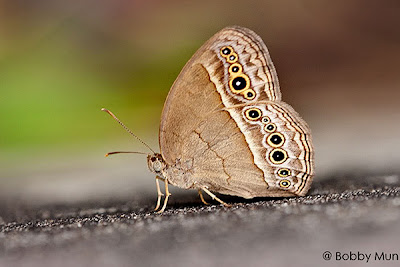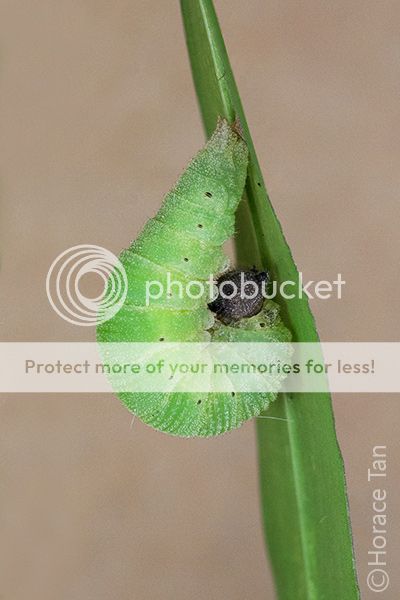Butterfly Biodata:
Genus: Mycalesis Hübner, 1818
Species: perseoides Moore, 1892
Subspecies: perseoides Moore, 1892
Wingspan of Adult Butterfly: 40-50mm
Caterpillar Local Host Plants: Ottochloa nodosa (Poaceae), Ischaemum ciliare (Poaceae).
Physical Description of Adult Butterfly:
On the upperside, the wings are dull brown with a prominent yellow-ringed ocellus in space 2 of the forewing, and two obscure ocelli in spaces 2 and 3 of the hindwing. The male has a dark brown sex brand above vein 7 in the hindwing covered with a hair pencil. On the underside, both wings are pale brown in ground colour and have a whitish post-discal band. There is a series of ringed ocelli in the submarginal area on both wings. In the forewing, there are four faint lines (obscure in the wet season form but more readily seen in the dry season form) crossing the basal half of the cell. In the hindwing, the post-discal line is slightly curved in spaces 4 and 5, and there is a prominent dark brown indentation line stretching down to and beyond vein 1b with a "tooth" at vein 1b.
Field Observations of Butterfly Behaviour:
Once thought to be rare, this species is now a common member of the Mycalesis genus in Singapore. Adults are typically sighted flying low among vegetation in and around grassy patches found at multiple locations across the island nation. As with other Satyrinae members, the adults fly in an erratic and jerky manner as their wings are closed for a relatively long period during flights.
Early Stages:
Two local common grass species, Ottochloa nodosa and Ischaemum ciliare, have been recorded as larval hosts so far. The caterpillars feed on leaves of the host plant, and have been observed to forcefully ejecting their frass pellets, a larval habit rarely seen outside the skipper/flat families. They tend to rest lengthwise on the underside of a leaf during pauses between feeds.
Local host plant: Ottochloa nodosa.
A mating pair of Burmese Bush Brown.
The eggs are laid singly on the underside of a grass blade. Each egg is more or less spherical (about 1mm in diameter) and pale translucent with a light greenish tinge. It appears to be smooth to the naked eyes, but faintly sculptured with a hexagonal reticulum when viewed with a macro lens.
A mother Burmese Bush Brown laying an egg on its host plant.
Two views of an egg of Burmese Bush Brown.
Two views of a mature egg with the head clearly visible through the egg shell.
The egg takes about 3 days to mature. The young caterpillar nibbles away a portion of the egg shell to exit and then proceeds to devour the rest of the egg shell almost entirely. It has a cylindrical body in whitish colour, and an initial body length of about 2.8mm. The body is covered with dorso-lateral and lateral rows of moderately long setae. At the posterior end, there is a pair of backward-pointing processes. Its dark colored head features a number of setae and has a pair of short and rounded horns, a few lateral protuberances.
Two views of a newly hatched caterpillar, length: 3.1.mm
As a result of its leaf diet, the 1st instar caterpillar soon takes on a strong greenish undertone. As growth proceeds, the dorsum of the last two to three segments turns reddish. The first instar lasts about 4 days with the body length increases to about 5.5-6mm.
Two views of a 1st instar caterpillar, length: 4.9mm.
Two views of a late 1st instar caterpillar, dormant prior to its moult, length: 4.5mm.
In the 2nd instar, the cephalic horns become pointed and the two anal processes longer and thus pronounced. The few lateral conical protuberances on the head capsule are now much smaller and whitish in colour. The body color is pale yellowish with a green undertone. The head and body is also adorned with numerous minute tubercles, each with a single seta emanating from it. The 2nd instar lasts about 3 days with the body length reaches about 9mm.
Two views of a 2nd instar caterpillar, early in this stage, 4.5mm.
Two views of a 2nd instar caterpillar, length: 5.4mm.
Two views of a late 2nd instar caterpillar, dormant prior to its moult, length: 8mm.
The 3rd instar caterpillar mostly resembles the previous instar. The head capsule is dark brown in the cephalic horns and the basal areas around the mouth parts but pale brown elsewhere. This stage also takes 3 days to complete with body length reaching about 13-14mm.
Two views of a newly moulted 3nd instar caterpillar, length: 9mm.
Two views of a 3nd instar caterpillar, length: 12mm.
Two views of a late 3nd instar caterpillar, dormant prior to its moult, length: 13mm.
The 4th instar caterpillar bears a close resemblance to the 3rd instar caterpillar with no obvious change of any features or markings. The 4th instar lasts about 4 days with body length reaching 20.5-21.5mm.
Two views of a newly moulted 4th instar caterpillar, length: 13.5mm.
Two views of a 4th instar caterpillar, length: 17mm.
Two views of a late 4th instar caterpillar, dormant prior to its moult, length: 21.5mm.
Burmese Bush Brown caterpillars in the act of catapulting frass pellets. The next moult brings the caterpillar to its 5th and final instar. Now the caterpillar could appear in two colour forms: a brown form which is mostly pale to dark beige brown and a green form which is pale yellowish green. Feature wise, there is now a narrow band on the dorsum of the thorax. In addition, small black dorso-lateral spots appear at the joints between segments 2 to 7. Furthermore, faint oblique stripes adorns the body surface. In a period of 8 days, the body grows to a maximum length of about 32-35mm. Two views of a newly moulted 5th instar caterpillar, length: 20mm. Two views of a 5th instar caterpillar, green form, length: 29mm. Two views of a 5th instar caterpillar, brown form, length: 35mm. Two views of a 5th instar caterpillar, late in this stage, body shortened and body colour changed to mostly green, length: 22mm. Toward the end of the 5th instar, the body gradually shrinks in length and the body of both colour forms turn mostly green. Finally the caterpillar finds a spot on the underside of a leaf blade to spin a silk pad. It then secures itself there via its anal end, and assumes its upside-down pre-pupatory pose. A prep-pupa of Burmese Bush Brown. After one day as a pre-pupa, pupation takes place. The smooth pupa is mostly green throughout. It is somewhat angular in appearance, with a dorsal keel on the thorax and ridges defining the dorsal wing margins. There are a few small black spots dotting the wing pad margin. Dorso-lateral pairs of small yellowish spots can be observed on abdominal segments 2-6. Length of pupae: 15-16mm. A Burmese Bush Brown caterpillar moults to its pupal stage. Three views of a pupa of Burmese Bush Brown. After 5 days of development, the pupa becomes darkened in color, and the ringed-spot on the forewings can now be seen through the pupal skin in the wing pads. The next day the eclosion event takes place with the adult butterfly emerges to start the next phase of its life cycle. Three views of a mature pupa of Burmese Bush Brown. A Burmese Bush Brown caterpillar emerges from its pupal case. A newly eclosed Burmese Bush Brown. References:
- [C&P4] The Butterflies of The Malay Peninsula, A.S. Corbet and H.M. Pendlebury, 4th Edition, Malayan Nature Society.
- Butterflies of Thailand, Pisuth Ek-Amnuay, 2nd Edition, 2012.
- A Field Guide to the Butterflies of Singapore, Khew S.K., Ink On Paper Communications, 2010.






























1.jpg)
